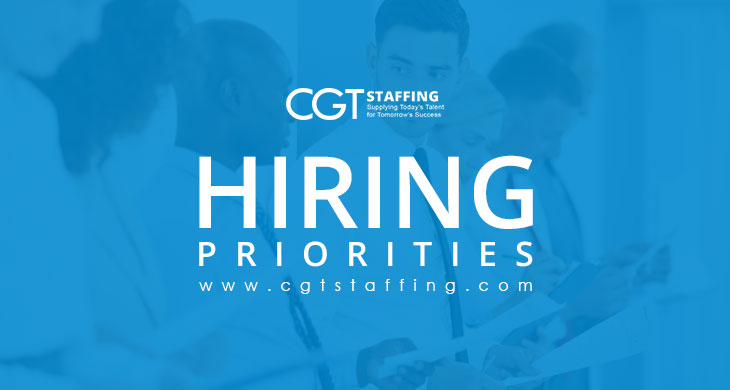Hiring processes are much more efficient than they used to be in the pre-digital age. With hiring systems and software, and the extensive penetration the internet has had among the global workforce, recruiters have access to larger talent pools and a higher quality of candidates.
Unfortunately, this also means there are often far too many applicants to whom to give due attention, increasing the chances of missing on a very talented candidate that perfectly met your needs for a specific role.
Even automated systems like applicant tracking and management software can sometimes overcomplicate the process of finding the best candidates for an open role. However, many times, fixing this is simply a matter of identifying and crystallizing your hiring priorities for the role you need to fill. Read on for an overview on how to approach this.
Table of Contents
A Simplified Approach to Identifying Hiring Priorities
A staffing agency connects employers with suitable candidates for roles every day. As a hiring manager or recruiter, the final decision on who you select for that role depends heavily on your input. Professional recruitment firms usually have very clear, streamlined, and effective processes that weed out unsuitable candidates and ensure better hiring success.
There will always be other factors that can make or break the hiring decision, based on what you need from your perspective of the ideal candidate. In other words, the candidate that is hired will usually be the one with the skills and expertise to match your hiring priorities for a role.
These priorities, therefore, offer a benchmark for in-house recruiters and managers to measure a candidate in their talent pipeline against. How do you identify these priorities in the first place? A structured but simplified approach usually works best in most business situations and identifying and prioritizing the qualities you seek in an environment works no differently.
Of course, business specifics and processes may vary. You may feel the need to add more to the steps we will look at below. But here are a few very simple but effective ways on how to define your hiring priorities.
The 3 Must-Have Factors a Candidate Should Have
Bulk hiring is fairly common in many industries. With interest rates dropping to zero to keep the economy flowing during COVID-19, any mortgage staffing agency can attest to the volume of candidates passing through their hands.
Whether or not you’re directly involved in the hiring process, both in-house and third-party recruiters need your input on what you would need from a candidate. This acts as the first line of qualification, or the minimum you need from a candidate. Not only does this help recruiters screen out candidates and save time, but also helps candidates screen themselves and apply elsewhere with a higher chance of success.

It is usually a good idea to have between 3 to 5 critical qualities you require from a candidate for them to be considered. These can be anything from academic credentials, to experience, to charisma, to communication, to even being a team player. The specifics of what you prioritize will always vary with the specifics of the role and your own talent acquisition strategies.
However, listing down the core requirements can help you lock onto the candidates that meet them, and focus the hiring process on them.
The 3 Motivations a Candidate Should Have To Apply
Of course, what you want from the candidate is crucial to business success. It is also important to consider what you are offering that motivates the ideal candidate to apply for the role. Draw up a list of between 3 to 5 motivators you are offering that are specific to the job or role, not to the overall firm or company.
Your employer branding is important, but that comes further down the process. In many cases, talented workers are usually more concerned with your post for, say cybersecurity consulting, offers when they check it out.
Motivators aren’t necessarily limited to huge paychecks. Challenging work, growth potential, fringe benefits, perquisites, and much more can all make a role seem far more attractive to a candidate as well. Be sure to crystallize what you are offering for the role and whether it seems enough to attract the type of qualified candidate you defined in the first step.
The 3 Reasons a Candidate Wants To Work for You
Finally, you want to consider what you offer to your workforce that makes you a desirable employer. This is also what is known among the hiring industry as your employer brand. It enables recruiters to pitch the best parts of working for you, such as the work culture, the location, the amenities like an on-premises gym or pool or games, etc.
You want to distill 3 to 5 attributes that would be the most appealing to a prospective candidate. Workplaces are just as important as the work itself and can have a significant impact on your workforce’s performance appraisals. You can set the right tone early on with an accurate employer brand as a priority for your hiring message.
